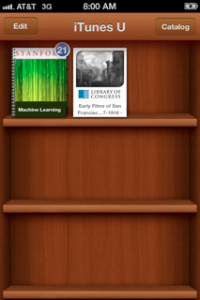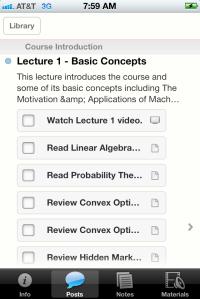You have /5 articles left.
Sign up for a free account or log in.
 iTunes U has long been one of the hidden gems of the iTunes Store, and even with some new features announced yesterday to the online learning platform, it appears that it's again set to be overshadowed. That's hardly surprising -- the news about digital textbooks and their "reinvention" was the focus of the press event.
iTunes U has long been one of the hidden gems of the iTunes Store, and even with some new features announced yesterday to the online learning platform, it appears that it's again set to be overshadowed. That's hardly surprising -- the news about digital textbooks and their "reinvention" was the focus of the press event.
On stage at the Guggenheim Museum, Apple's Eddy Cue boasted that iTunes U had over 1,000 schools participating in it. With over 500,000 pieces of audio/visual content, it is the largest catalog of online educational content. Some 7 million files have been downloaded since iTunes U was launched in 2007.
iTunes U has, up 'til now, been just that: files to download. Although most of the content is lecture podcasts (in video or audio form), there have also been course documents and slideshows as well.
Yesterday, Apple gave iTunes U a substantial refresh, with a new iTunes U app (iTunes link) that, Apple's words, contains "full online courses." The app consolidates all the course materials into one place, so that learners can view all the course materials and assignments and can check off the latter when completed. The new courses also contain supplemental materials from outside the iTunes U -- materials, it's worth noting, that aren't all free (unlike the rest of the iTunes U content). This includes links to related iBooks and apps. By pulling all this together into one app, students are now able to store their notes (including any highlights from the related iBooks) as part of the app.
 Apple also announced yesterday that it's going to allow K-12 schools to participate in iTunes U (something previously restricted to higher ed and a few museums, libraries, and public television stations). Once approved by Apple to submit content, educators will be able to construct their own iTunes U courses via a Web interface.
Apple also announced yesterday that it's going to allow K-12 schools to participate in iTunes U (something previously restricted to higher ed and a few museums, libraries, and public television stations). Once approved by Apple to submit content, educators will be able to construct their own iTunes U courses via a Web interface.
The new iTunes U app works on both iPhones and iPads (although the layout is snazzier on the larger screen size of the latter).
What's missing from the app is something also missing from the other half of Apple's announcement yesterday: any social learning component. It's a fairly striking omission (okay, maybe not terribly surprising since Apple's latest venture into "social" was the ill-fated Ping) considering the moves towards supplementing great OER content with opportunities for learners to connect with one another -- study groups via OpenStudy, for example. Even though the latest version of iOS has Twitter integration, there isn't even a way to Tweet "Hey, look at me, I'm working through the Stanford Machine Learning class" (or rather "Help! I'm working through the Stanford Machine Learning class!")
This missing piece reflects a model where a learner learns alone -- with a collection of great resources, true, but no support from others. Apple may have built a pseudo-LMS here in support of free educational content. But it doesn't feel like the direction that the rest of the LMS industry is going -- recognizing that learners want and need to share and learn together.

